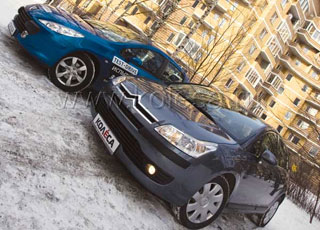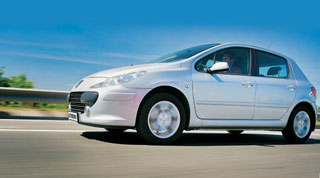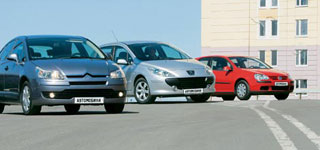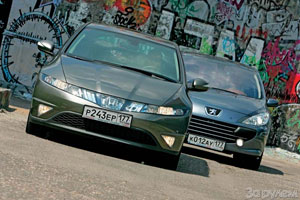PEUGEOT 307 Test drive 5 doors 2005 - 2008 hatchback
The world for two
 They have a lot of common features, but these are different cars. Each of them is like a projection of another in a parallel dimension.
They have a lot of common features, but these are different cars. Each of them is like a projection of another in a parallel dimension. They are an example of how the corporate style does not lead to unification, but lays a strong foundation, giving birth to the basis for building individuality. Citroeon C4 and restyled PEUGEOT 307: 10 doors, 3.2 liters and 10 automatically switched gears for two.
We were the first to notice: they stand out even in the most colorful environment. At a night club or restaurant, where expensive foreign cars lined up with dense rows, each of the cars will not fade and not get lost. The stylish, vivid and recognizable appearance of each of the hatchback again made me enthusiastically speak about the features of the French design word. Citroone C4 first sparkled last year. PEUGEOT 307 four years earlier, but restyling of the end of 2005 breathed a new wave of freshness into the Frenchman. Working on the appearance of C4, the Citroenovites borrowed part of the already finished technical solutions (platform, engines, chassis, transmission) with well -proven peugeot nodes. And the saved funds about a third of the billion euros were allowed to develop design, which later became the secret of its success. Revolutionary, extravagant, brave. What did they achieve Peugeot Facelift? The update had to be up to the court: in the view of the car there was a feeling of something new, the radiator grille acquired the family grin, but there was no global change in the image. That's the restyling. All the same lion cub with familiar habits. Another thing is the habits themselves, for which they praised three hundred and seventh: how much did Citroen adopted them? We will find out the engines, but for now it’s worth a closer look at the interior.
There are more differences in the cabin than similarities. True, the same radio tape recorders and climate control controls are on the central console. In addition, the automatic checkpoint control panel is identical. In principle, that's it. Otherwise, these are two different cars. Restyling is not very penetrated into Peugeot, but the revolution in design completely moved to the C4 salon. If the non-triviality of the early lamb Citroen consisted in their single-pointedness, then there are two knitting needles in the new steering wheel, and between them a fixed hub with fixed radio control buttons and climate control. Not the most convenient solution, but how original!
Everything is traditional in Peugeot: behind the habitable steering wheel, there is a panel of no less familiar devices with speedometer and tachometer. In Citrooen, most of the information comes from a low elongated liquid crystal screen, on which there are no dials only electronic information. And the tachometer is located in the center of the steering wheel and is an electronic strip with numbers. Which option is better incomprehensible. Information on the liquid crystal screen is recognized well, but at first it was unusual. Although for aesthet, such chips may be crucial. The seats of both cars in French gently take the body immersed in them, but the grip of lateral support seemed tougher and tangible in Peugeot.
The cost of both cars is almost the same. The only difference is that the prices for Peugeot are set in rubles, and in Citrooen in dollars. When counting, we get about 21,000 (Peugeot) and 20,700 (Citroeon) for a five-door hatchback with an automaton and a 1.6-liter engine in a far from the poorest configuration. In each of the French there were front and lateral airbags, a radio tape recorder, a two-zone climate control (option). But in Peugeot heating the front seats only goes as an option (in the standard only in the top configuration or when choosing a leather salon), in Citrooen heating is placed in the SX Pack version. In addition, in all C4, the headlight washer and cruise control, the owners of the peppers will have to pay for them to pay extra.
 We have on the test two absolutely identical 1.6-liter 110-horsepower engines equipped with an automatic Porsche Tiptronic automatic box. Both units are characterized by a lack of traction on the bottoms and a lack of a decision -making rate in automatic transmission. The gearbox is adaptive, that is, it will adapt to the driver’s manner of driving and will switch when the sitting at the wheel needs it. But for this she needs time. As a result, we get: we are in the extreme left row, from which most standing in front of us seeks to go to a turn or turn to the left.
We have on the test two absolutely identical 1.6-liter 110-horsepower engines equipped with an automatic Porsche Tiptronic automatic box. Both units are characterized by a lack of traction on the bottoms and a lack of a decision -making rate in automatic transmission. The gearbox is adaptive, that is, it will adapt to the driver’s manner of driving and will switch when the sitting at the wheel needs it. But for this she needs time. As a result, we get: we are in the extreme left row, from which most standing in front of us seeks to go to a turn or turn to the left. And we need straight. The sport mode, a look in the right mirror is the time, the turning signal, the brake up, the gas on the floor seemed to last eternity: at first the car jerked a little, then fell silent, then rolled out with increased engine speeds, the clutch was felt, and only then I started and I was able to rebuild and continue moving. Here it is, a fee for comfort and measured calm when moving in traffic jams. The mechanics are spared the slowness of the machine gun, in addition, according to the factory data, acceleration of a 1.6-liter engine with a mechanical box up to 100 km/h takes 2.5 seconds less!
Both Frenchmen have excellent sound insulation and pleasant silence of the engine. The passage of the cars is smooth, the buildups are minimal, and the brakes are reliable and understandable in use. Both cars are well balanced, and during the dough day significant constructive differences in behavior did not surf. Unless, of course, the difference in rubber, which initially introduced us into some misconception. It was like this: Peugeot 307 reacted very clearly and quickly to the actions of the steering wheel, obediently followed the chosen trajectory. I liked it very much. But crossing to Citroeon, I was surprised that C4 showed an even greater honescence of actions, interesting severity and sharpness. But constructively, the suspension and steering are almost the same?! When looking at the rubber, everything fell into place. Citroone received a head of the all -season Michelin, while Peugeot had winter Nokian. Probably, hence the great softness of the 307th stroke compared to C4: just all-season tires under the influence of minus temperature became much tougher than the winter rubber of three hundred seventh.
The fruits of globalization: twins-one-platforms in fact turned out to be equally high-quality, but completely different cars. The C-class hatchbacks, perhaps, with the brightest in comparison with competitors, offer completely different philosophy. Citroeon C4 is a large original, non -trivially solving image issues. PEUGEOT 307, even despite restyling, no longer surprises with non -standard forms, but goes through minimal changes, and so having a catchy and attractive appearance.
Obviously, the choice between cars will be made primarily at the emotional level: whoever likes more and choose that. In this regard, let's not forget that the five -door C4 has a relative minus: it is less stylish than the three -door will have to choose between the practicality of five doors and the elegant dynamism of Coupe. Three hundred seventh does not make this difference. But inside, in our opinion, Citroeon is more interesting. What to choose?
Cars for the test are provided by car dealerships auto-exis and motor
Text: Alexander Korobchenko
Photo: Roman Ostanin




















Source: Wheel magazine [No. 102/2006]








